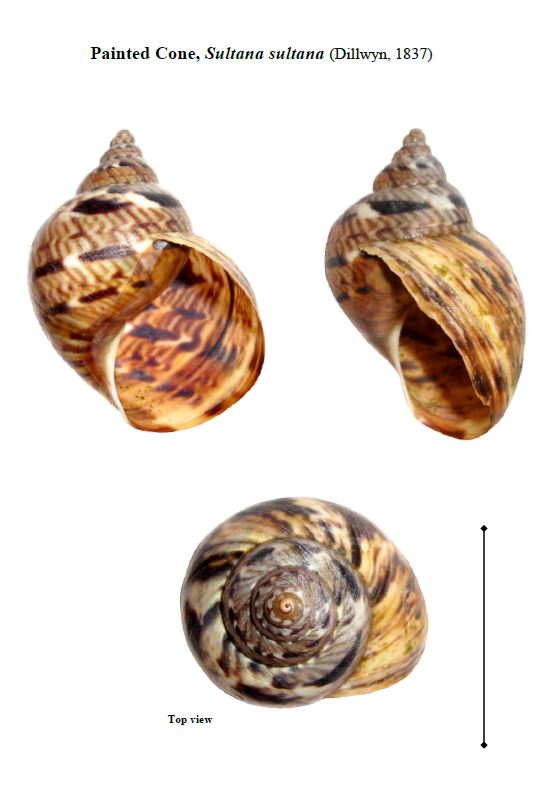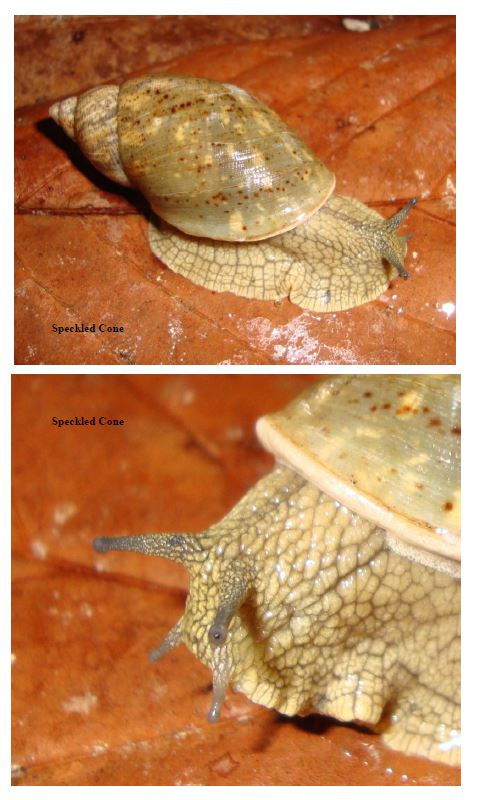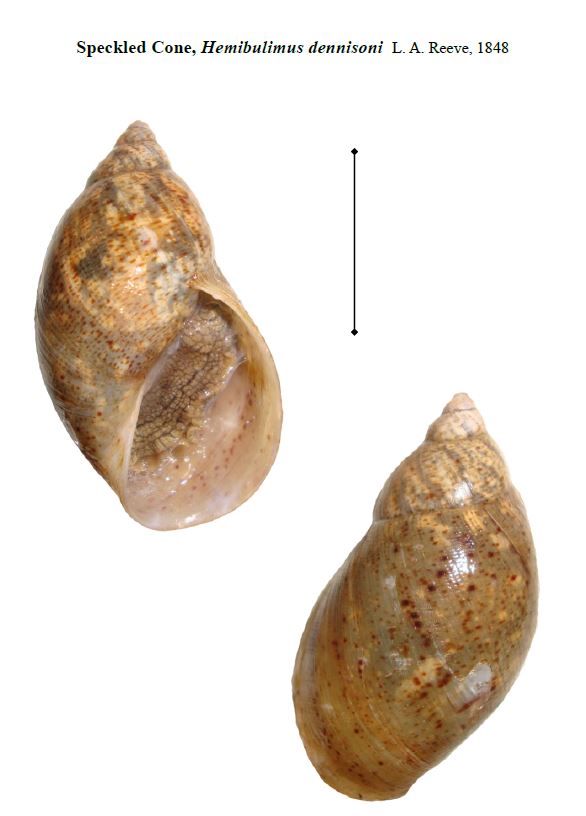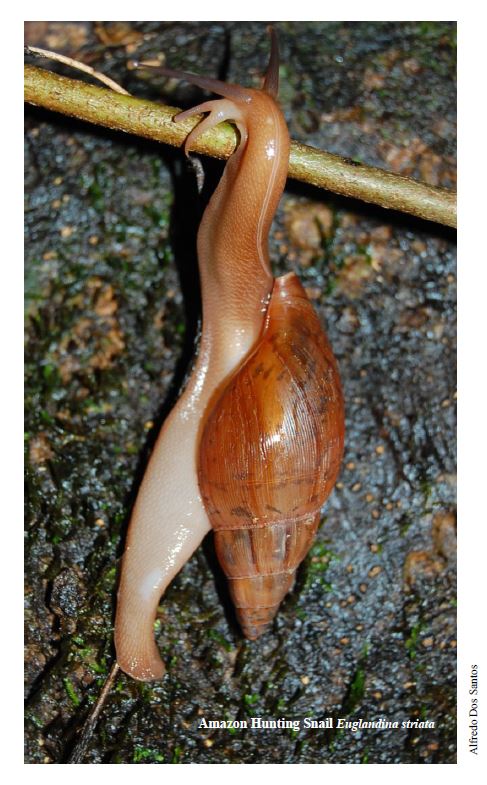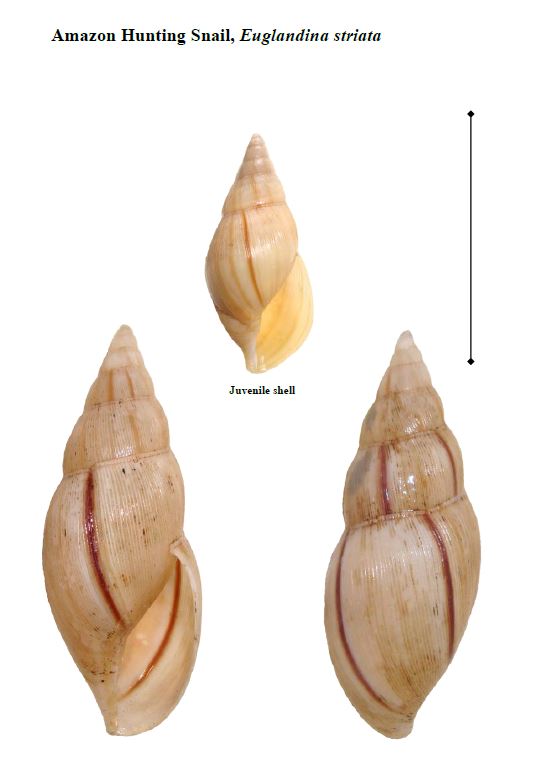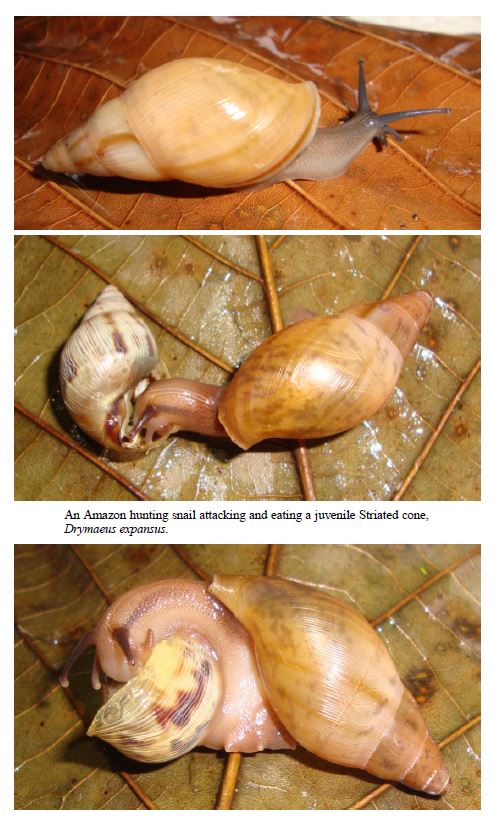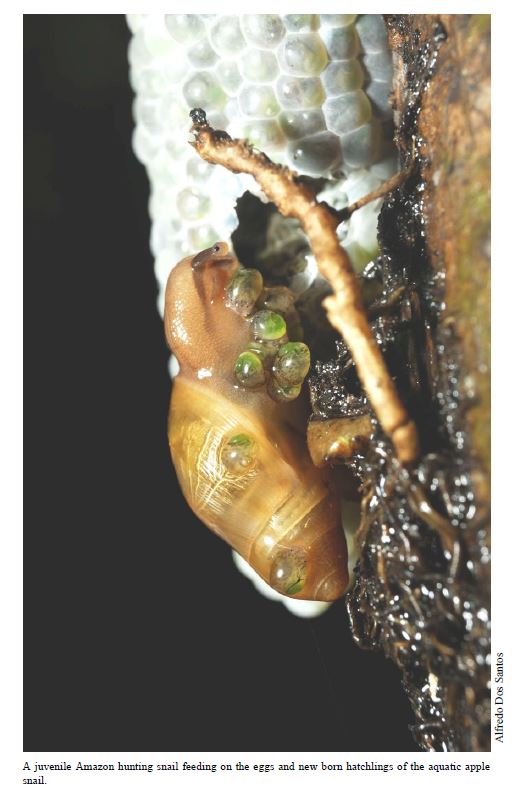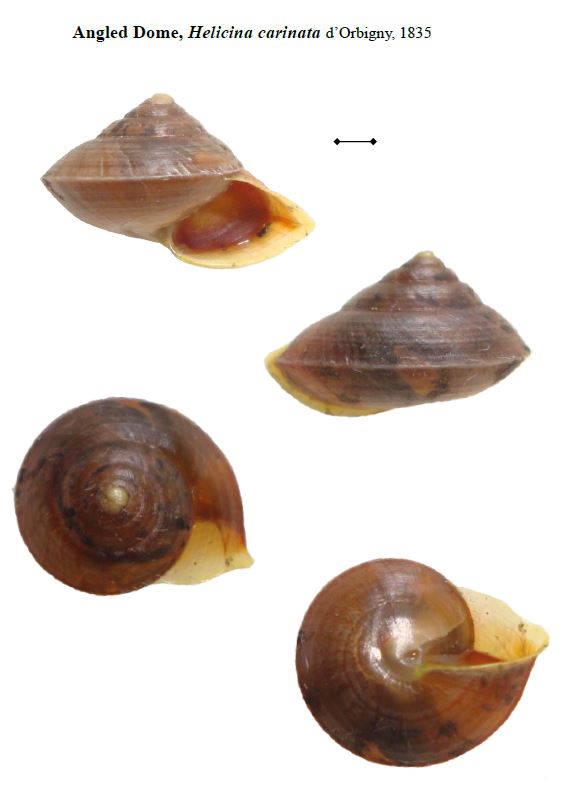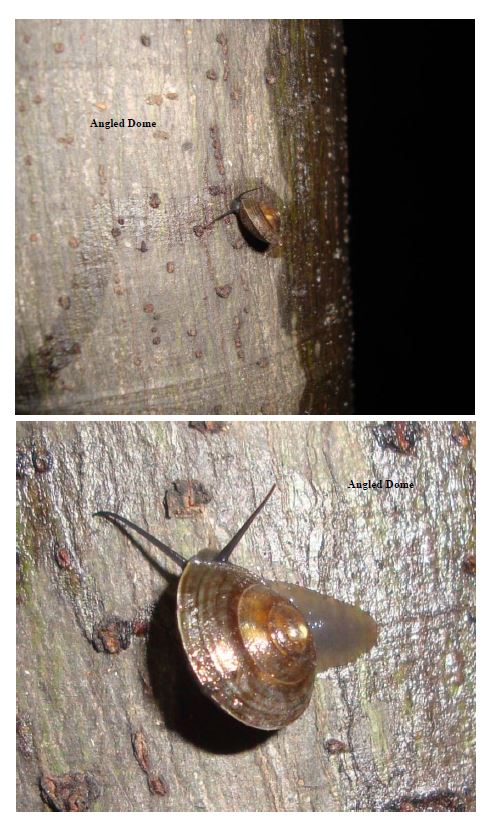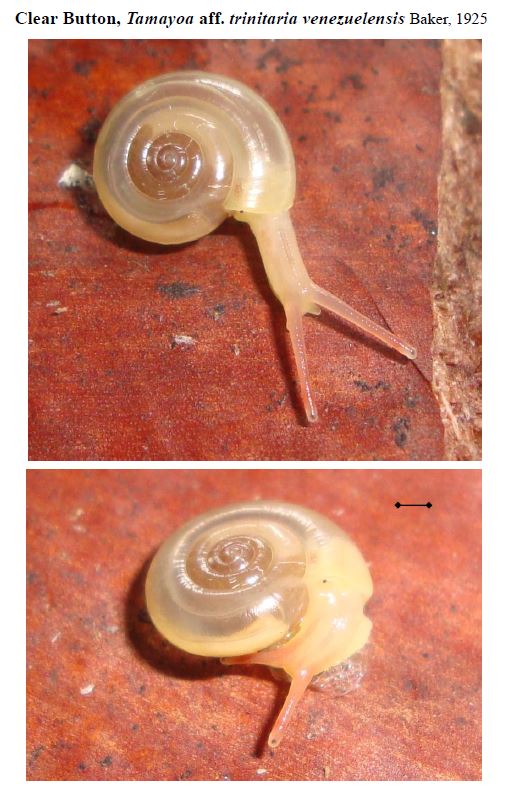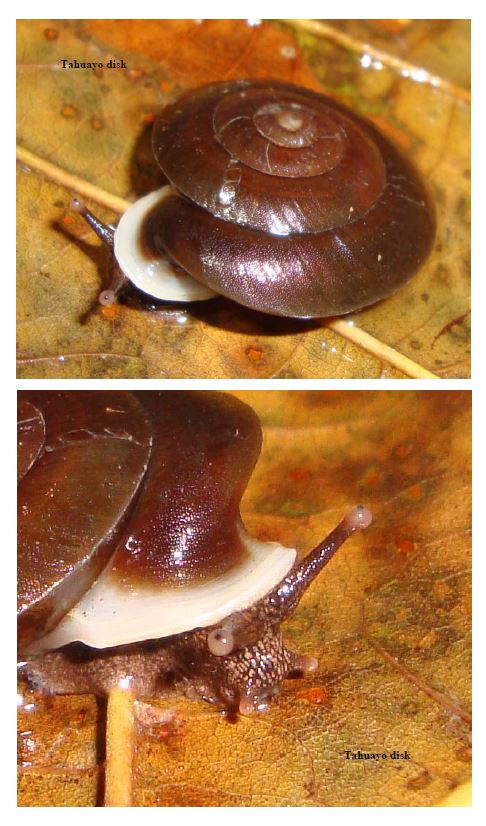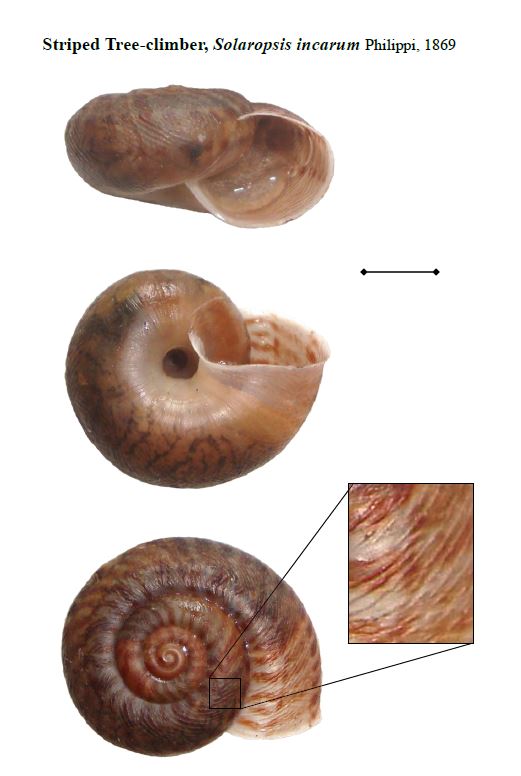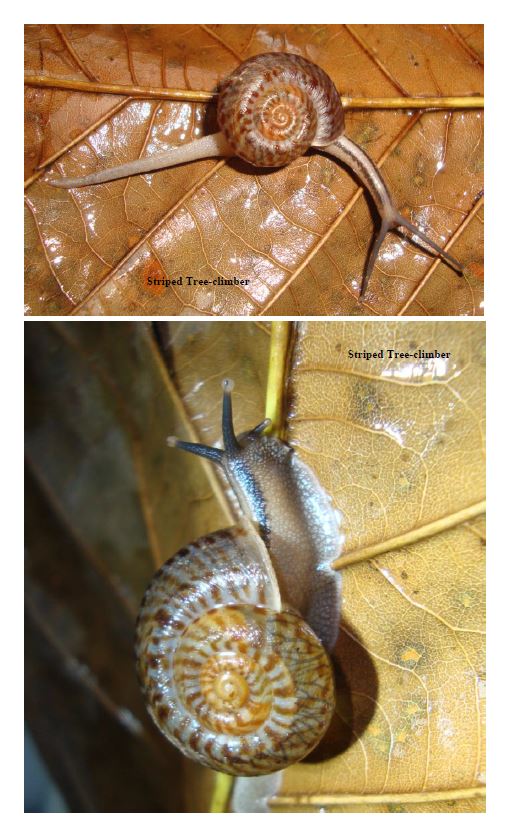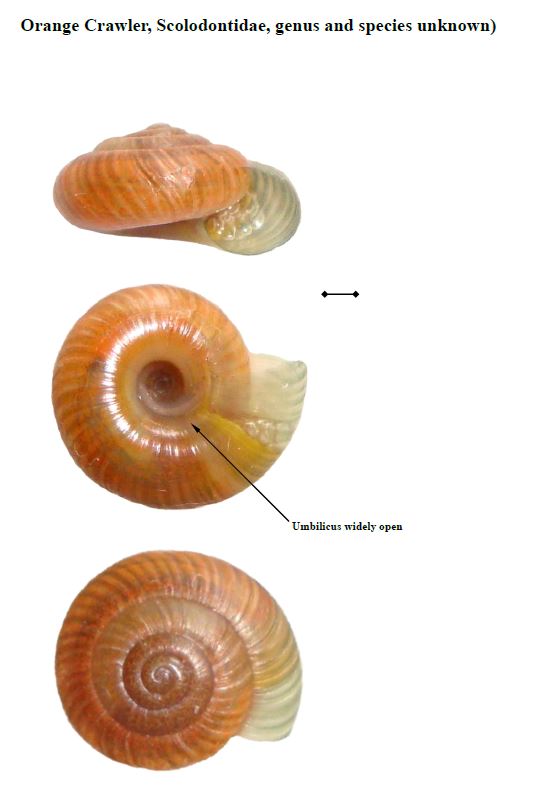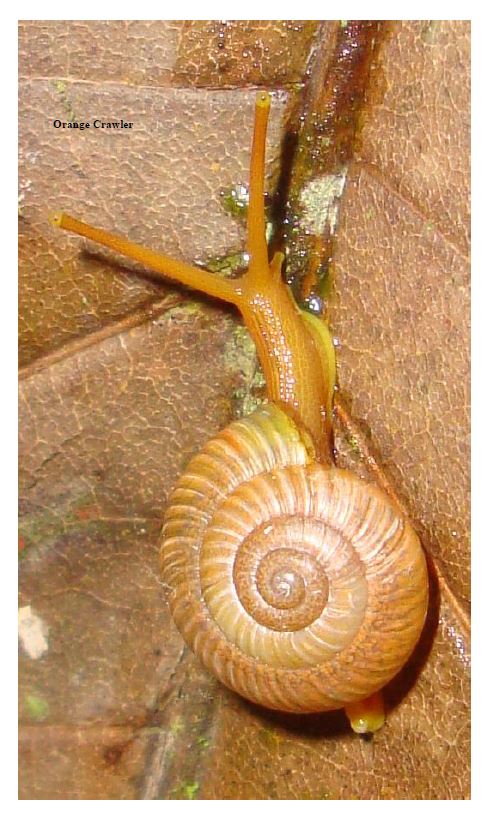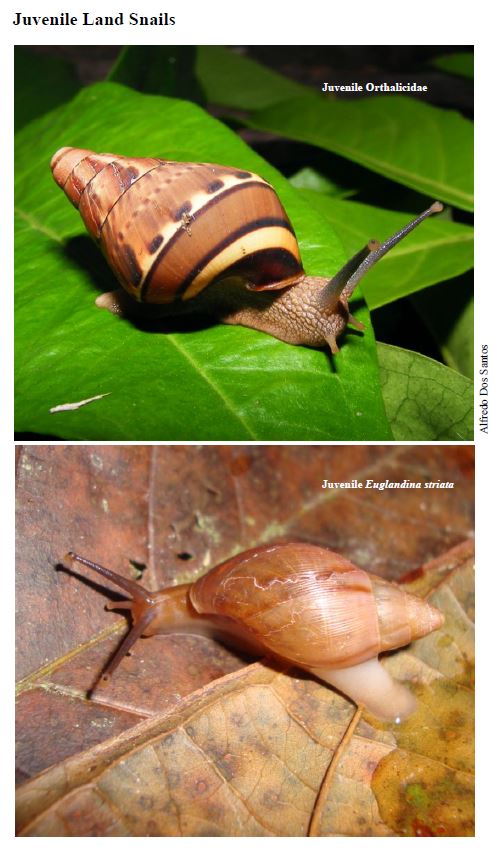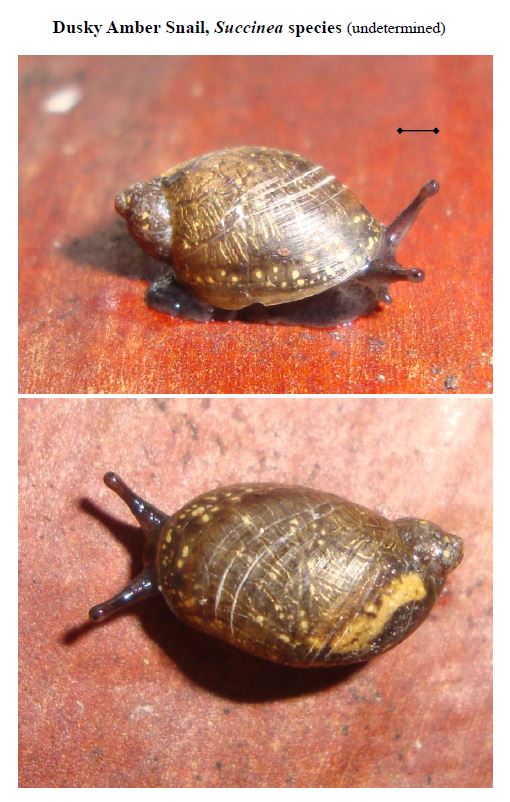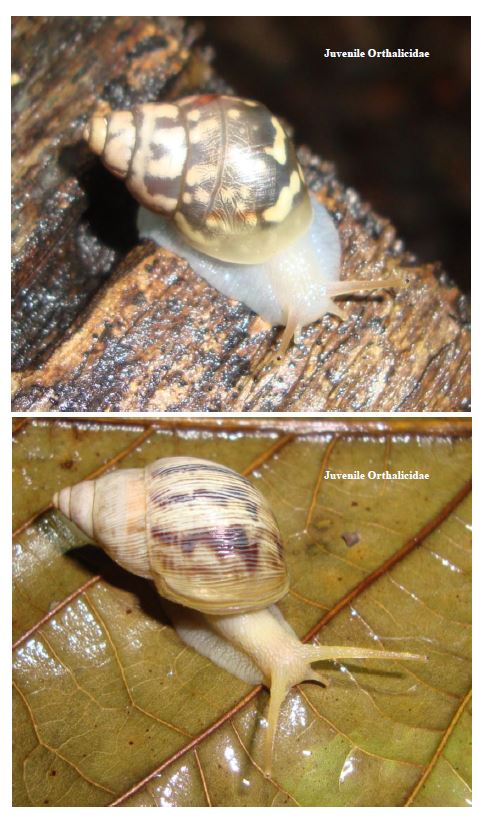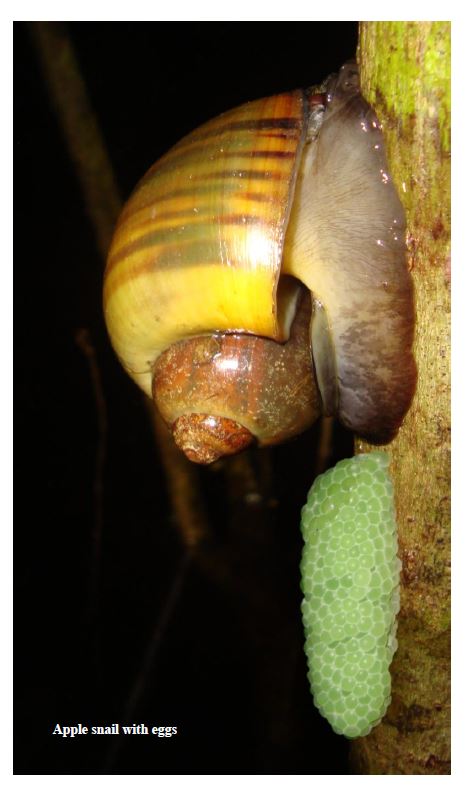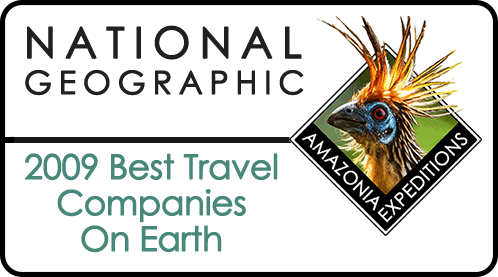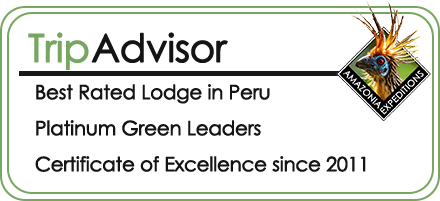Research at the Tahuayo Lodge:
Gastropods of the Tamshiyacu-Tahuayo Communal Reserve
Dan and Judy Dourson 2013
Supported by Amazonia Expeditions Guides and Logistics
Amazonian Land Snail Survey
In 2013, biologists Dan and Judy Dourson contacted Amazonia Expeditions to inquire about the possibility of studying land snails at our lodge. The conversation resulted in a 16-day research trip to the Tahuayo Lodge, Amazon Research Center Lodge, and Terra Firme forest in the Tamshiyacu-Tahuayo Communal Reserve where they conducted a cursory land snail survey. This survey aimed to provide preliminary documentation of the diversity of land snails in this vast, biodiverse region. The expedition documented 15 species of land snails, representing 11 families, with several species remaining unidentified including one exciting find the Doursons dubbed the Orange Crawler which they are now investigating as a potentially undescribed species. This preliminary assessment, facilitated by Amazonia Expeditions logistics and research support, underscores the reserve’s rich biodiversity and highlights the importance of further research to uncover the full extent of its malacological fauna. Future research could include a more extensive study of the land snail fauna and interspecies relationships that include an investigation of the diet of the black caiman.
The Researchers
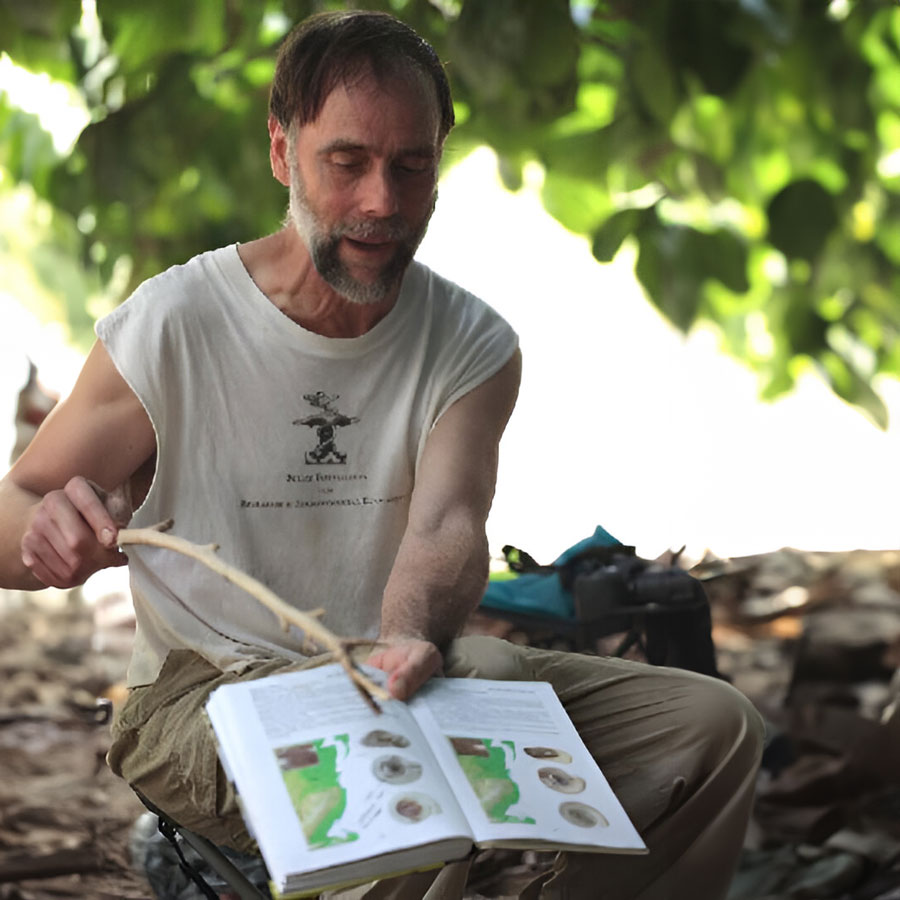
Dedicated to Land Snail Conservation and Biodiversity Research
Daniel C. Dourson
Daniel C. Dourson is a biologist, naturalist, wildlife illustrator and photographer who has spent most of his adult life dedicated to the preservation, conservation, and understanding of the planet’s more obscure plants and animals. For nearly twenty years, he worked with the US Forest Service, as a wildlife biologist specializing in nongame management in Red River Gorge in Kentucky, USA. Dan has spent more than 35 years studying land snails in the eastern United States, Central America, and in the Amazon Jungle of northwestern Peru. He has described 9 new land snail species from the US and 17 new species from Belize, Central America. In 2019-2020, Dan and his wife, Judy conducted a statewide land snail survey funded by the Office of Kentucky Nature Preserves (OKNP) that resulted in the second edition of the Land Snails of Kentucky (in production).
Dan is the author of 14 Natural History books including Wild Yet Tasty, Wildflowers & Ferns of Red River Gorge, Reptiles and Amphibians of the Red River Gorge, Biodiversity of the Maya Mountains, Belize, Central America, Land Snails of Kentucky, Land Snails of Belize, Land Snails of the Great Smoky Mountains and Southern Appalachians, and Land Snails of West Virginia.
A Focus on Conservation and Education for All Ages
Judy Dourson
Judy Dourson is an educator, researcher, editor, publisher, and field assistant who is dedicated to educating people of all ages about the natural world and how to conserve and protect it. From 1978-2006, she was an educator in the Powell County School System in the Red River Gorge area of Kentucky where she specialized in elementary math and science education and working with gifted and talented students. In 2006, Dan and Judy traveled to Belize to manage a Biological Field Station called BFREE (Belize Foundation for Research and Environmental Education) for 7 years in the wild jungles of Central America. From 2006-2016, they conducted land snail surveys across Belize, increasing the known land snail fauna in Belize from 24 species to 154 with 17 species new to science that are described in Land Snails of Belize.
Dan and Judy’s research is largely self-funded, the result of their desire to share their passion for the natural world and in particular, land snails, with biologists and the general public in the USA and abroad in Belize, Peru, and Panama. In 2023 and 2024, they traveled to Panama, where they collaborated with the Smithsonian Tropical Research Institute (STRI), studying the land snails of Barro Colorado Island and across Panama with the ultimate goal of producing Land Snails of Panama in both English and Spanish.

The Study
Introduction
A cursory survey to document the diversity of land snails of the Tamishyacu-Tahuayo Communal Reserve was conducted in February of 2013. Principal investigator was Dan Dourson, biologist and malacologist with field assistance from Judy Dourson, and Alfredo Dosantos Santillan, resident biologist at the Amazon Research Center. The results of this rapid assessment are reported.
The phylum Mollusca is a diverse group of organisms that includes chitons, aquatic and terrestrial snails, slugs, clams, oysters, mussels, nautilus, squid and pulpos (Ramirez et al. 2003) and is second only to arthropods in terms of species diversity making this group one of the most successful on the planet (Bruggen 1995).
In general, understanding of land snail diversity, ecology and distribution is vastly incomplete, particularly in tropical regions of the world and South America is no exception. The first and only registered list of land snails of the continent were conducted by Morelet in 1863 with 190 species recorded. In the past century, malacologists who have contributed significantly to the knowledge base of the terrestrial mollusks include Weyrauch who described 136 species from Peru between 1930-1970. He collaborated with other well-known malacologists of the day including Pilsbry. From the middle part of the 1900’s till the present time, much of the collecting in Peru has been conducted by few private individuals and a handful of researchers. Most recently, Ramirez et al. (2003) conducted studies in western Amazonia in Peru of land snails in the genera, Megalobulimulus and Systrophia in 2001 as well as examination and compilation of the available literature both past and present in order to produce a list of mollusca for Peru. In their work, Ramirez et al, states that much work is still to be done, especially in the examination of private and past collections housed in various locations throughout the world.
Currently, the number of recorded land snail species (an estimated 800 taxa) from Peru is probably around 38% of the fauna (Ramirez et al. 2003; Thompson 2011); an estimated 62% of the total fauna remains undiscovered awaiting scientific description. Examination of collections mentioned above as well as targeting the micro snail fauna (less than 5mm in diameter) will no doubt yield new species to Peru and to science.
The preliminary rapid assessment of the Tamishyacu-Tahuayo Communal Reserve focused entirely on the macro snails greater that 5 mm in diameter and is likely the first study of the land snail fauna of this region. The inaccessibility of the densely and often flooded forests has no doubt been a deterrent to past collectors, leaving the reserve entirely unsampled for this interesting group of organisms. Future study of the area should focus on leaf litter collections (on higher ground that is not subject to flooding) and examination of bromeliads in order to include the micro snails.
Study Area
Peru is a country rich in terms of both species diversity and habitats containing 84 of the 103 life zones of the Holdridge System (ONERN 1976). Located on the Pacific Coast of South America in the Neotropical Biogeographic Region, the presence of the Andes Mountain range and the Humboldt Current make Peru a country of contrasts (Tarazona et al. 1998).
Located in northeast Peru, the Area de Conservacion Regional Comunal de Tamshiyacu-Tahuayo(ACRCTT) exceeds 1.1 million acres, covering more than 1600 square miles it has more land area than does the state of Rhode Island (1045 sq. miles. South of Iquitos just off of the Amazon River, the reserve encompasses areas around the Tamshiyacu and Tahuayo Rivers eastward toward the border of Brazil. The reserve is currently adding a million acres of undisturbed forest onto its boundary, which will then include land all the way to Brazil’s border.
The ACRCTT was designated in 1991 by the Peruvian government—in response to local concerns about resource rights and conservation concerns related to the presence of an exceptionally diverse primate species through a collaboration of local communities concerned about overexploitation of resources by commercial fishermen, loggers, and hunters from Iquitos, and biological researchers.
It is believed that the ACRCTT remained tropical forest during the Pleistocene era when the rest of the Amazon became a dry savannah. Known for its unprecedented mammal diversity, it is thought to be the greatest of any region of the Amazon. The highest number of primate species known to occur within a park or protected area in the world is within the ACRCTT. Scientists studying birds, amphibians, and plants have found the respective species assemblages to be “outstanding, unusual and exceptional.”
Based on this brief survey of land snails of in a small portion of this area, it is expected that the diversity of land snails, especially endemic snails would match the finding of other taxa in terms of diversity. This remains to be seen.
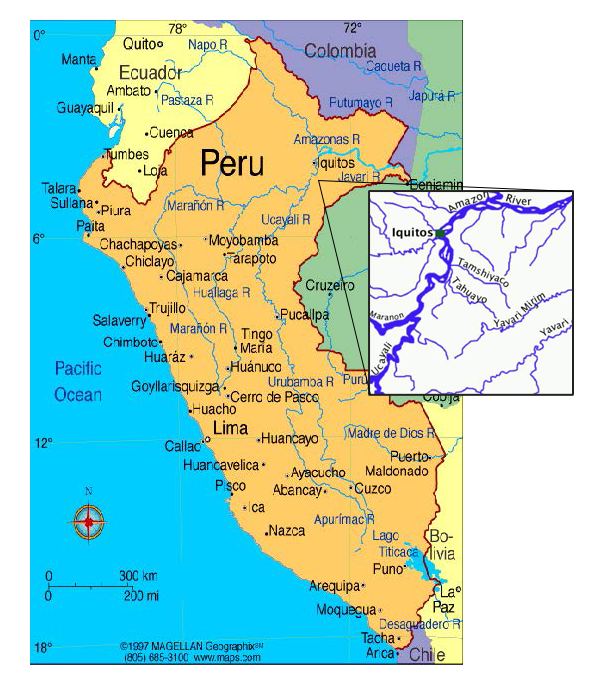
Survey Methods
In most regions of the world, land snails are typically surveyed by targeting specific habitats: arboreal epiphytes (bromeliads and orchids), leaf litter on the forest floor, rocky outcrops, rock crevices, and logs; under exfoliating bark of standing and/or down dead trees; hollow trees damaged trees oozing sap which attracts snails; under and on top of caps of fungi; under moss mats and the crotches of trees.
In the Amazon basin, the seasons play a pivotal role in a determining site selection and in particular ,survey methods. During the rainy season, land snails crawl up on vegetation in order to prevent drowning. Surveying for land snails normally done by foot on dry ground during the dry season is done predominantly by boat.
This cursory land snail inventory was conducted to gain general understanding regarding the possible habitats and the species diversity in targeted habitats near the Tahuayo Lodge and the Amazon Research Center in the flooded forest in a fraction of the total area of the ACRCTT.
The Tahuayo Lodge and the Amazon Research Center in conjunction with Amazonia Expeditions is the only organization permitted to conduct ecotourism on a limited basis within the ACRCTT.
The undersides of vegetation and tree trunks were targeted as the waters of the Tahuayo River continued to rise during the survey period from January 28-February 15, 2013 The other main habitat targeted in this survey was the terra firme (high ground 40 m or more above sea level). Tierra firme forest includes fairly well-drained nutrient rich soils and is usually very rich in tree species, with a dense upper canopy and a relatively dark, open interior.
Only macro snails (>5mm) were documented during this survey. No leaf litter samples to survey for micro snails were taken.
No live animals were collected and all snail shells were deposited with Alfredo Dosantos Santillan, biologist, at the Amazon Research Center. Images of each snail encountered were taken by the author or Alfredo then identified using a combination of resources including Thompson’s Annotated Checklist and Bibliography of the Land and Freshwater Snails of Mexico and Central America (2011), Inventario preliminar de los moluscos terrestres y de agua dulce del área de la Reserva Los Amigos (Ituarte et al. 2008), Pilsbry’s Land Mollusca (1940, 1946, 19480 with taxonomy following Bouchet and Rocroi (2005).
Results
A total of 15 species representing 11 families with two species of terrestrial mollusks that could not be assigned to genus or species (including one slug) and two species that could not be assigned to species were recorded. Below the table documenting the species is an assortment of plates and photos of the snails that were found during this survey.
Species Identification Plates
The following plates represent the gastropods documented. The scale bars represent actual size of the shell of each species. When possible, images of the live animal were included. Three standard views of shells that are heliciform in shape were represented while conical shells were photographed with a front and side view for diagnostic purposes. Click on any of the images below to view an enlarged version.
References
Abbott, R. T. 1989. Compendium of Landshells. American Malacologists, Inc. Melbourne, Florida.
Bonato, V., K. G. Facure, and W. Uieda. 2004. Food habits of bats of subfamily VAMPYRINIAE in Brazil. Journal of Mammology. 85 (4):708-713.
Bouchet, P. and J. Rocroi. 2005. Classification and nomenclator of gastropod families. Malacologia 47(1-2).
Bruggen, 1995 (mollusks most successful)
Burch, J. B. 1962. How to know the eastern land snails. Wm. C.. Brown Publishing Company. Dubuque, Iowa. 214 pgs.
Burch, J. B. And T. A. Pearce. 1990. Terrestrial Gastropoda. Pp. 201-309 in D. L. Dindall (ed.), Soil Biology Guide. Wiley and Sons, Inc., New Jersey.
Dallinger, R. 1993. Strategies of metal detoxification in Terrestrial invertebrates. in: Dallinger, R. and Rainbow, P. S. (eds.). Ecotoxicology of Metals in Invertebrates. Lewis Publishers. Boca Raton, Florida. Pp. 245-289.
Dallinger, R. and W. Weiser, 1984a. Molecular fractionation of Zn, Cu, Cd, and Pb in the midgut gland of Helix po-matia L. Comparative Biochemistry and Physiology. 79:125-129.
Dallinger, R., B. Berger, C. Gruber, Hunziker, P. and S. Stuzenbaum. 2000. Metallothioneins in terrestrial inverte-brates: structural aspects, biological significance, and implications for their use as biomarkers. Cellular and Mo-lecular Biology 46:331-346
Dourson, D. 2008. The feeding behavior and diet of an endemic West Virginia land snail, Triodopsis platysayoides. American Malacological Bulletin. 26:153-159
Dourson, D., R. Caldwell, W. Garcia, and K. Loukes, 2011. Land snails of the Bladen Nature Reserve with notes on their significance to other organisms in southern Belize (Toledo District), Central America. Mesoamericana 15(3):31-42.
Fairbanks, H. L. 1998. Clarification of the taxonomic status and reproductive anatomy of Philomycus batchi Branson, 1968. The Nautilus 112(1):1-5.
Gervais, J., A. Traveset, and M. F. Wilson. 1998. The potential for seed dispersal by the banana slug (Ariolimax columbanus). American Midland Naturalist 140:103-110.
Graveland, J. R., J. H. van der Wal, J. H van Balen, and A. J. van Noordwijk. 1994. Poor reproduction in forest pas-serines from decline of snail abundance on acidified soils. Nature 368:446-448
Graveland, J. R. 1996. Avian eggshell formation in calcium-rich and calcium-poor habitats: importance of snail shells and anthropogenic calcium sources. Canadian Journal of Zoology 74:1035-1044.
Hames, R., K. V. Rosenburg, J. D. Lowe, S. E. Barker, and A. A. Dhondt. 2002. Adverse effects of acid rain on the distribution of the woodthrush Hylocichla mustelina in North America. Proceedings of the National Acad-emy of Sciences. 99 No. 16.
Hogue, C. L. 1985. Cultural Entomology. Annual Review of Entomology. Vol. 32: 181-199.
Hogue, C. L. 1993. Latin American insects and entomology. University of California Press.
Holdridge, L. R., W. C. Grenke, W. H. Hatheway, T. Liang, & J. A. Tosi, Jr. 1971. Forest environments in tropical life zones: a pilot study. Pergamon Press, Oxford, UK.
Iremonger, S. and N. Brokaw 1995. Vegetation classification and mapping methodology as a basis for gap analysis of protected area coverage in Belize. in: Towards a National Protected Area Systems Plan for Belize. Programme for Belize & Inter-American Development Bank Synthesis Report.
Ituarte, C., G. Cuezzo, and R. Ramirez. 2008. Inventory of terrestrial and freshwater mollusks Reserve Los Amigos (Peru, Madre de Dios).
Kottek, M., J. Grieser, C. Beck, B. Rudolf, and F. Rubel. 2006. World Map of the Köppen-Geiger climate classifica-tion updated. Meteorologische Zeitschrift 15(3): 259-263
Lee, J. C. 1994. The Amphibians and Reptiles of the Yucatán Peninsula. Cornell University Press, Ithaca /. London.
Machensted, U, and K. Markel. 2001. Chapter 4: Radular structure and function. Pp. 213-236 In: G. M. Barker ed. The biology of terrestrial mollusks. CABI. New York, NY.
Moritz, C., K. S. Richardson, S. Ferrier, J. Stanisic, S. E. Williams, and T. Whiffin. 2001. Biogeographic concor-dance and efficiency of taxon indicators for establishing conservation priority in a tropical rainforest biota. Pro-ceedings of the Royal Society London B 268:1875-1881.
Oficina Nacional de Evaluacion de Recursos Naturales – ONERN. 1976. Mapa Ecologico del Peru. Guia Explica-tiva. Lima: ONERN.
Pearce, T. 2008. When a snail dies in the forest, how long will the shell persist? Effect of dissolution and micro-bioerosion. American Malacological Bulletin 26:111-117.
Peters, J.A. 1960. The snakes of the subfamily Dipsadinae. Misc. Publ. Mus. Zool. 114: 224.
42
Pilsbry, H. A. 1940. Land mollusca of North America (north of Mexico), Vol. I. Part 2. The Academy of Natural Sciences of Philadelphia Monographs.
Pilsbry, H. A. 1946. Land mollusca of North America (north of Mexico), Vol. II. Part 1. The Academy of Natural Sciences of Philadelphia Monographs.
Pilsbry, H. A. 1948. Land mollusca of North America (north of Mexico), Vol. I. Part 2. The Academy of Natural Sciences of Philadelphia Monographs.
Platt, S. G., T. R. Rainwater, A. G. Finger, J. B. Thorbjarnarson, T. A. Anderson, and S. T. McMurry. 2006.Food hab-its, ontogenetic dietary partitioning and observations of foraging behaviour of Morelet’s Crocodile (Crocodylus mo-reletii) in northern Belize. Herpetological Journal 16:281–290.
Ramirez, R. V. Borda and P. Romero. 2012. Biodiversidad y endemismo de los caracoles terrestres Megalobulimus y Systro-phia en la Amazonia occidental. Rev. peru biol. [online]. 9:59-74 . Disponible en: <http://www.scielo.org.pe/scielo.php?script=sci_arttext&pid=S1727-99332012000100008&lng=es&nrm=iso>. ISSN 1727-9933.
Tarazona, J. & S. Valle. 1998. La diversidad biológica en el mar peruano. p. 103-115. In G. Halffter (comp.): La diversi-dad Biológica de Iberoamérica III. Volumen especial. Acta Zoológica Mexicana, nueva serie. Instituto de Ecología, A.C., Xalapa, México.
Thabah, A. & Y. W. Gang Li. 2007. Diet, Echolocation Calls, and Phylogenetic Affinities of the Great Evening Bat (IA IO; Vespertilionidae): Another Carnivorous Bat. Journal
Thompson, F. 2011. An annotated checklist and bibliography of the land and freshwater snails of Mexico and Central America. 903 p. Available: http://www.flmnh.ufl.edu/malacology/mexico-central_america_snail_checklist/ [Online: 16 June 2008.]
A Secluded Stay in the Heart of the Jungle
Visiting the Amazon Research Center
This research was supported by Amazonia Expeditions – an ecotourism company in the Peruvian Amazon dedicated to the environmental and cultural preservation of the region. For travelers visiting the Amazon for at least 5 days – there is the option to stay at our Amazon Research Center (ARC) for all or part of your adventure. While the accommodations of this lodge are more modest than our main Tahuayo lodge– guests who are visiting the jungle to experience its spectacular biodiversity will find the pristine, undisturbed forest it provides access to well worth it. The ARC is the only existing man-made structure in the million acre ACRCTT conservation zone with the nearest human habitation over 15 km away.



